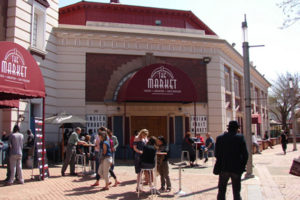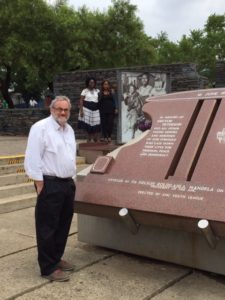*This is the fourth and final essay in a series of “We the Audience” posts designed to introduce my readers to the citizen artists working in some of South Africa’s most challenged areas. [For a look at all four essays, start reading here.] Today’s essay focuses on Malcolm Purkey, who, of course, does not actually need an introduction. As a key figure in the anti-apartheid theatre scene in Johannesburg in the 1970s and 80s, Purkey remains one of the city’s cultural leaders and an important voice for social change through arts activism.
One of the first things Malcolm Purkey tells me as we drive toward the city center is that Johannesburg is the world’s largest urban center with no natural waterway as part of its topography. Jo’burg was established in 1886 not by colonists looking for a logical settlement site (water being both the source of life and the most effective means of travel), but by treasure hunters looking for the next El Dorado. The city sits on the Witwatersrand, a 56-kilometer slice of sedimentary rock filled with a variety of precious metals, among them gold and diamonds. He points out what remains of the gold mining industry as we zoom up the highway.
I am lucky to be getting one of Malcolm’s famous cultural tours of Jo’burg. Lucky for two reasons: one, Purkey is a native and knows the city intimately; and two, he is an utterly fascinating person with such a rich professional story that I feel like I’ve been dropped inside one of the history of theatre textbooks I use in my college classrooms. Throughout his forty + year career, Malcolm’s artistic life has been indelibly tied to his political consciousness as a South African citizen—there is no separating the “art” from the “politics” or his artmaking from his social practice. He began his career at the Nunnery and Junction Avenue theatres in the 1970s, where he worked with other activists to challenge apartheid and developed a workshop methodology for mixed race ensembles to create socially engaged material. Now in his mid-60s, he currently serves as Dean of the Johannesburg branch of the AFDA School of Film, Television and Performance while continuing to write and direct new work. His list of awards is too long for this essay, but you can check it out here.
Our first stop is the internationally renowned Market Theatre in the Newtown section of the inner city. The site is a former produce market built in the late 1880s soon after the city was first settled; today the space retains the original Edwardian three-cornered roof and iron façade, but the unrestricted interior of the eastern side of the market has given way to three theaters (proscenium, thrust and a flexible configurations) and a series of lobby, lounge and dining venues. As we wander through the building Malcolm greets former colleagues—he was the Artistic Director here from 2005 to 2013 and is still actively involved as a visiting director. In between greetings he offers me two important facts about the Market Theatre’s history:
- It began as a “non-racial” theatre, meaning that black, colored and white audiences inter-mixed in open defiance of the apartheid regime’s “separate amenities regulations.”
- It continued as the country’s major “struggle” theatre during the apartheid era, with the mission to stage original South African material, including a canon of now-famous protest plays such as Woza Albert, Bopha, Purkey’s own Sophiatown, and a host of Athol Fugard premieres.
From Newtown we head toward Soweto. On the way we talk about the current state of theater in South Africa. Malcolm is critical of the commercial turn the industry has taken; he wonders aloud about the efficacy of socially progressive theatre in the post-apartheid era. Now that the revolutionary moment is past, what kind of role should a new era of critically engaged theater take? Is there still enough interest in plays that dramatize social change to keep the lights on in a place like the Market Theatre?
By this time we’ve arrived in Soweto (an acronym for Southwest Township) and are driving slowly along the narrow streets lined with small, government built houses and jerry-rigged shacks. Soweto was established as part of the apartheid government’s forced removal of all non-white Johannesburg residents, and it is of course famous for the student uprising in 1976 that brought the reality of apartheid to the world’s attention.
Malcolm points out Mandela’s house (he lived in Soweto from 1946 to 1962), now a museum and heavily traveled tourist destination. We continue past and park at the Hector Pieterson Museum and Memorial.
Pieterson, one of the first casualties of the Soweto Uprising, was killed on June 16, 1976 and became a symbol of the brutality of the government’s armed response to a student-led protest march. Malcolm and I take in the outside memorial stone, and then I spend some time looking at the exhibit material outlining the apartheid government’s policies leading to the uprising. As most of us know, the protest began when the government imposed a regulation that only Afrikaans could be spoken in the public schools. It’s not a big mental jump to thinking about the present-day reactionary discourse in the U.S. over immigration policy.
It’s lunchtime. Malcolm takes me to the Maboneng precinct, a newly chic inner-city neighborhood (really just a few square blocks) engineered by a local property developer who is following the now familiar recipe for gentrification: start with the arts, add restaurants and clubs and a boutique hotel, then finish off with rich people moving in. It’s a bit surreal to be moving so quickly from the small houses and self-rigged tuck shops that line the streets of Soweto to these densely packed city blocks filled with hip hotels and restaurants, art galleries, a cinema and a fancy food market. Once we finish the free-for-all parking exercise that is distinctly South African (featuring the impressively creative use of all available surface space) and start walking along the main drag, I feel like we could be in any big city in Europe or North America.
We eat barbeque and fish at one of the restaurants, sip some Pinotage (a delicious local red blend), talk more politics and more art. The conversation turns to the current South African political landscape, from the daily headlines about the malfeasance of Jacob Zuma’s government to the overwhelming levels of violence in the major cities. “What is the next revolution?,” I ask. “Economic,” he responds without hesitating. He talks about the dismal status of the rand and the threat of junk bond status hanging over the country’s financial system. I talk about my shock at first seeing the level of poverty in the townships and informal settlements around Cape Town [go here for my essay on Frygrond and here for my essay on Langa, Philippi and Delft].
Malcolm listens for a minute before his eyes take on an interesting glint; he says he has one more neighborhood to show me. We finish our coffee quickly and get back in the car.
Within just a few minutes we’re driving down a wide boulevard walled in by high-rise buildings. Windows are broken, pipes hang lifelessly, trash climbs the outside walls. The sidewalks are filled to bursting with ad-hoc street vendors and pedestrians. So is the boulevard itself. Malcolm steers the car in, around and through various groups of people and objects blocking the street. No one is paying any attention to the traffic lights (robots) or the signs. To my left I see scores and scores of women, dressed in robes and head ties, sitting along the sides of the buildings. They appear to be waiting, or lining up, but I’m not sure for what. We pass a man holding the legs of a few newly decapitated chickens. Rap music blares from multiple sources. Young women in fashionable western clothing move in groups along the sidewalks while talking on cell phones. Children run in and out of the dilapidated apartment houses, or stand on shaky balconies yelling down to the street. People move in and out of the many storefront businesses. Conversation. Laughter. Horns honking, engines idling.
This is the Hillbrow section of inner city Johannesburg: a vertically populated neighborhood with an estimated 50,000 residents, 95.6 percent of them Black African. The majority of residents are migrants from the S.A. townships or from other parts of Africa. In the 1960s Hillbrow was a wealthy “whites only” section of apartheid-era prosperity. It began going “gray” in the 1970s as it became known for it’s progressive politics and openly gay and lesbian residents. Hillbrow is now notorious for what happened after apartheid ended and street soldiers armed with AK47’s took over many of the high-rises, literally high-jacking them for the rent. It has a reputation as a lawless place. Police are scarce. Landlords hire commercial security companies
https://www.youtube.com/watch?v=hHk7h71hGxw
to come in and reclaim their buildings. I am overwhelmed by the sights and sounds of these few city blocks.
The car is quiet as we continue to drive, and soon we’re heading up Constitution Hill on the western edge of Hillbrow. Today it’s the site of the Constitutional Court of South Africa, the nation’s supreme court. Fascinatingly, it used to be the site of the infamous Old Fort Prison, where Mahatma Gandhi, Nelson Mandela and thousands of other dissidents were held while they awaited trial. When the prison was torn down, some of the bricks were used to construct the new court building.
It’s been a day of distances—from gold mines to theaters to halls of justice. I’m grateful to Malcolm for his time, his thoughts, and the chance to better understand his city.



[…] South Africa’s Citizen Artists: Malcolm Purkey and Johannesburg, from Soweto to Hillbrow**This is the fourth and final essay in a series of “We the Audience” posts designed to introduce my readers to the citizen artists working in some of South Africa’s most challenged areas. [For a… … read moreAJBlog: We The AudiencePublished 2016-06-13 […]
[WORDPRESS HASHCASH] The comment’s server IP (66.33.193.103) doesn’t match the comment’s URL host IP (66.33.193.74) and so is spam.